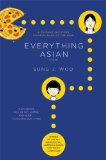
Critics' Opinion:
Readers' Opinion:
First Published:
Apr 2009, 336 pages
Paperback:
Jul 2010, 336 pages
 Book Reviewed by:
Book Reviewed by:
Beth Hemke Shapiro
Buy This Book
When I glanced at the cover of Everything Asian,
which features a grinning adolescent Asian boy about
to devour a huge hamburger, I envisioned a book
about twelve-year-old David Kim's culture clashes as
a newly arrived Korean immigrant in the United States. I was right; the book is filled with Korean practices
juxtaposed against experiences in this country. But
it is a book overflowing with so much more than
that, too. Sung J. Woo writes not only from
David's perspective, but also from the standpoint of
the many characters David knows from the Peddlers
Town mall, the microcosm of America where the Kim
family's gift shop is located.
Holding an MFA degree from New York University, Woo
has published many of his essays and short stories
in The New York Times, KoreAm Journal,
and Storyglossia. His strength as a short story writer is apparent in this, his first novel. In a style similar to that of Maeve Binchy or Kate Jacobs, Woo carefully shapes each chapter as its own vignette, presenting a single character's experience as a
potentially stand-alone story, while at the same
time developing a seamless novel.
The first story opens from David's viewpoint as a
newcomer to Oakbridge, New Jersey, becoming
acquainted with the father he has not seen in years,
and dealing with his older sister's depression. The
next chapter moves to the sister's perspective as
she takes stock of herself. While studying old
school pictures, she recognizes her "tired,
sick-of-this-world face" and realizes, "Maybe it
wasn't this new country that made her miserable.
Maybe the misery had always been inside her." Each
chapter continues with the tender study of a
character connected to the Kims through Peddlers
Town.
In addition to telling stories about these
individuals, Woo also introduces some unique Korean
cultural aspects. For example, in the chapter "Go
Fish," David describes a hwat-toe deck of cards:
Unlike American playing cards, these rectangles were made from thin hard plastic sheets about half the size of business cards, but they were far prettier... each revealed a nature scene... The moon was worth twenty points, and if I held the card that featured the same hill but no moon, I could've taken it, but all I had were three scenes of wheat fields and a cardinal perched on a cherry-blossom branch.
Thanks to Woo's details, I could
envision the Kims' shop quite vividly, filled with
small lacquered, decorative tables; wooden chests
containing one hundred miniature drawers; and a
four-paneled mother-of-pearl plaque depicting the
four seasons.
Don't be surprised that the book ignores the
youthful angst of David's school experiences; this
novel is aimed at adult readers, although young
adults may become engrossed in it as well. Instead,
the stories revolve around the small world of
Peddlers Town and those who work there, ordinary
people at an unremarkable shopping mall who became
special to me as Woo unfolded their unique
struggles.
![]() This review was originally published in May 2009, and has been updated for the
July 2010 paperback release.
Click here to go to this issue.
This review was originally published in May 2009, and has been updated for the
July 2010 paperback release.
Click here to go to this issue.
In 2008 there were more than 1.3 million people of Korean ancestry living in the United States, making Koreans the fourth largest group of Asian Americans, after Asian Indians, Chinese and Filipinos. As of 2000, roughly one-third of Korean Americans had been born in the United States, one-third are U.S. citizens born in Korea, and one-third are non-citizens.
The first wave of Korean immigrants came to harvest sugar on the Hawaiian Islands at the turn of the twentieth century, long before Hawaii became the 50th state. These migrants were part of a larger group of Asians who made the trans-Pacific voyage to work in the US and Latin America, often finding difficult and repressive conditions in the agricultural sector. Few other Koreans migrated to the United States in the first half of the twentieth century, because of race-based laws that excluded most Asians. Some interesting exceptions, however, included the
imported wives of Korean laborers living in the United States and the brides of U.S. servicemen returning from the Korean War.
Major reform to the US's immigration laws, the spirit of which was foreshadowed by President John
F. Kennedy's book A Nation of Immigrants, dramatically changed the rules of entry. From 1965 the main sources of new immigrants shifted from Europe to Latin America and Asia.
Today, Korean Americans live all over the USA, though they are concentrated in California and New York. Like many immigrant communities, they have been drawn to urban areas, and a number of U.S. cities have vibrant "Koreatowns.
Many present-day Korean Americans stay connected to one another through KoreAm Journal, the monthly magazine to which Sung J. Woo has contributed. Established in 1990, it claims to be "the most widely circulated (more than 40,000 readers), longest-running, independent English-language publication serving the Korean American community."
![]() This review was originally published in May 2009, and has been updated for the
July 2010 paperback release.
Click here to go to this issue.
This review was originally published in May 2009, and has been updated for the
July 2010 paperback release.
Click here to go to this issue.
Your guide toexceptional books
BookBrowse seeks out and recommends the best in contemporary fiction and nonfiction—books that not only engage and entertain but also deepen our understanding of ourselves and the world around us.